ANONYMOUS (19th century)* Ch'aekkori (Books and Writing Utensils) Six paintings mounted as a six-panel screen, ink and color on paper, 66 x 34 cm. each painting, mounted on brocade Ch'aekkori is among the most typical of Korean screen-painting subjects. Because the Chinese-style books are usually depicted closed, stacked in sets wrapped in slipcases, we call such paintings 'book-stack screens'. In addition to the sets of books, writing utensils like brushes, ink-cakes, inkstones, water containers, rolls of paper, and stone or ivory seals normally appear in these screens. The present example also contains a low, four-legged desk in each panel. (Yi-Dynasty scholars sat on thin cushions on the floor and worked at small, portable desks.) Like still-life paintings in the West, ch'aekkori often include fruit or flowers in the arrangements. The present screen shows citrons in a bowl at the top of panel two (from the right), eggplants in a bowl on panel three, peaches in a bowl on panel four, a bowl of grapes on the fifth panel, and a bowl of squash at the top of panel six, with a watermelon in a bowl on the desk below. The top of the watermelon is sliced off to reveal many seeds inside, a bit of Taoist symbolism suggesting that the screen's owner sire many children and thus achieve happiness and a kind of immortality. Luxury goods associated with the life of a gentleman are usually represented along with the books and scholarly paraphernalia on a ch'aekkori screen. In the present example we find a scholar's fur- lined cap and zither in panel one (from the right), a wine-pot, porcelain vase, lamp, fan, and two letters in panel two, two bronze jars with lids and a folded fan in panel three, a lidded brass jar, porcelain bottle with cup, a letter rack, and two letters in panel four, a porcelain jar with lid and a porcelain bottle with cup in panel five, and a lidded porcelain jar, letter rack, and two letters in panel six. Ch'aekkori is a Confucian theme, directly related to the scholarly aspirations of the yangban class (the landed gentry, the scholar-officials of the Yi-Dynasty government), yet book-stack screens were popular in the homes of commoners as well. Although literacy and luxury goods were not available to most commoners, a ch'aekkori screen added a sense of dignity and elegance to the home. It symbolized the Confucian ideals of education and self-improvement, hopefully providing inspiration to the family's children. Because of its Confucian theme, a book-stack screen also functioned as a talisman to insure that harmony would prevail in the household.
ANONYMOUS (19th century)* Ch'aekkori (Books and Writing Utensils) Six paintings mounted as a six-panel screen, ink and color on paper, 66 x 34 cm. each painting, mounted on brocade Ch'aekkori is among the most typical of Korean screen-painting subjects. Because the Chinese-style books are usually depicted closed, stacked in sets wrapped in slipcases, we call such paintings 'book-stack screens'. In addition to the sets of books, writing utensils like brushes, ink-cakes, inkstones, water containers, rolls of paper, and stone or ivory seals normally appear in these screens. The present example also contains a low, four-legged desk in each panel. (Yi-Dynasty scholars sat on thin cushions on the floor and worked at small, portable desks.) Like still-life paintings in the West, ch'aekkori often include fruit or flowers in the arrangements. The present screen shows citrons in a bowl at the top of panel two (from the right), eggplants in a bowl on panel three, peaches in a bowl on panel four, a bowl of grapes on the fifth panel, and a bowl of squash at the top of panel six, with a watermelon in a bowl on the desk below. The top of the watermelon is sliced off to reveal many seeds inside, a bit of Taoist symbolism suggesting that the screen's owner sire many children and thus achieve happiness and a kind of immortality. Luxury goods associated with the life of a gentleman are usually represented along with the books and scholarly paraphernalia on a ch'aekkori screen. In the present example we find a scholar's fur- lined cap and zither in panel one (from the right), a wine-pot, porcelain vase, lamp, fan, and two letters in panel two, two bronze jars with lids and a folded fan in panel three, a lidded brass jar, porcelain bottle with cup, a letter rack, and two letters in panel four, a porcelain jar with lid and a porcelain bottle with cup in panel five, and a lidded porcelain jar, letter rack, and two letters in panel six. Ch'aekkori is a Confucian theme, directly related to the scholarly aspirations of the yangban class (the landed gentry, the scholar-officials of the Yi-Dynasty government), yet book-stack screens were popular in the homes of commoners as well. Although literacy and luxury goods were not available to most commoners, a ch'aekkori screen added a sense of dignity and elegance to the home. It symbolized the Confucian ideals of education and self-improvement, hopefully providing inspiration to the family's children. Because of its Confucian theme, a book-stack screen also functioned as a talisman to insure that harmony would prevail in the household.
.jpg)
.jpg)
.jpg)
.jpg)
.jpg)
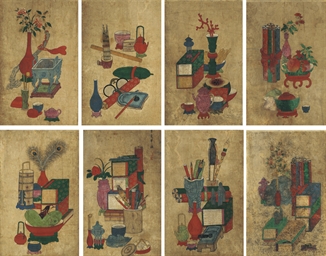
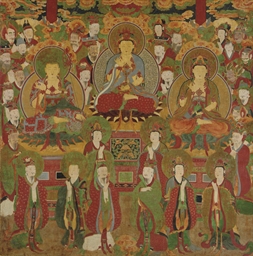
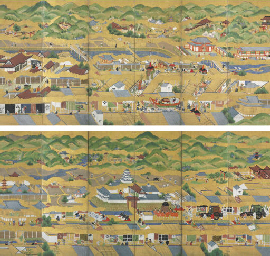
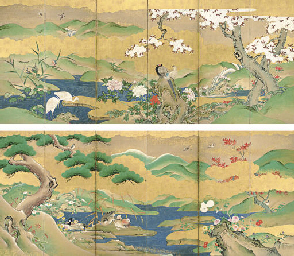
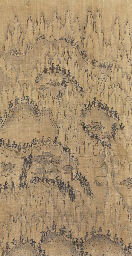
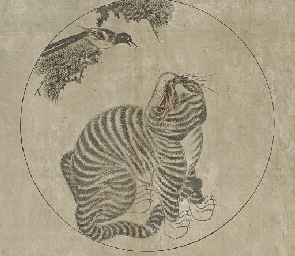
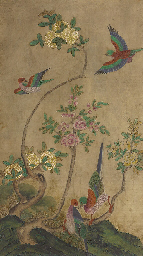
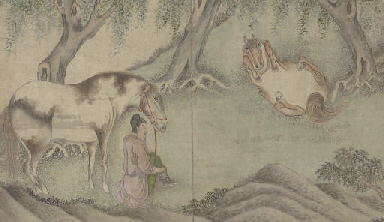
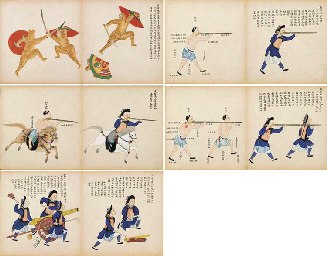
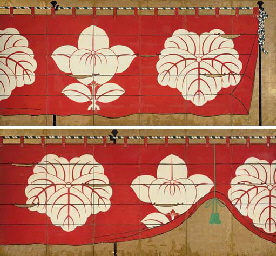
Try LotSearch and its premium features for 7 days - without any costs!
Be notified automatically about new items in upcoming auctions.
Create an alert